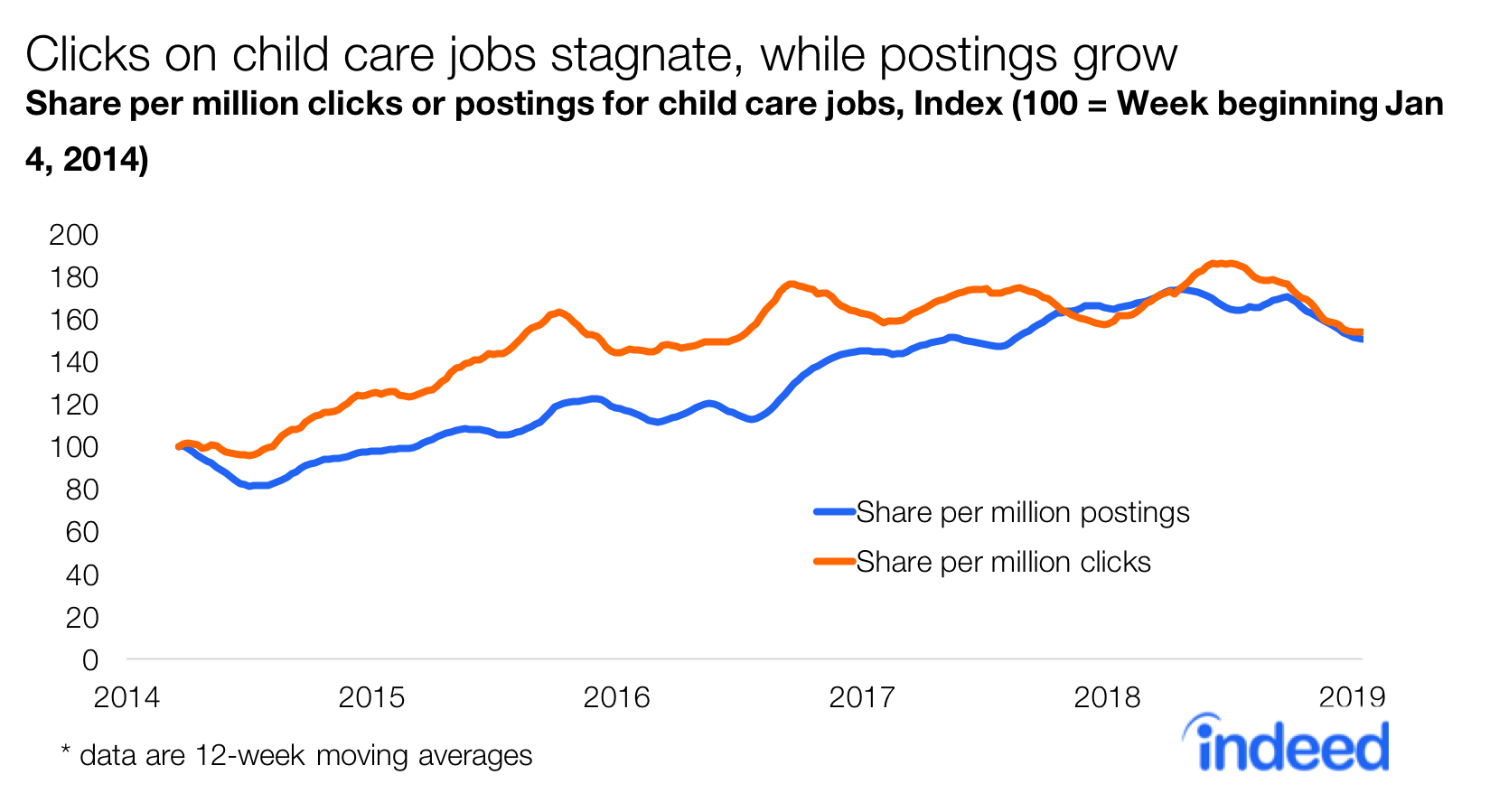Key points:
- Growth in job seeker interest in child care positions has slowed as the labor market has strengthened.
- At the same time, employer postings for child care work have accelerated as more people join the workforce.
- The child care job market gets hit twice in a tight economy: first, because of more demand for child care, and, second, because the low-wage workers who provide such care have more options.
- To expand interest in child care jobs, employers should consider raising pay, boosting job training, and adding other benefits.
Even though it’s early in the election cycle, presidential candidates are already trumpeting their policy ideas, and measures to improve access to child care are on the agenda. Sen. Elizabeth Warren of Massachusetts was the first Democratic candidate out of the gate on this issue, proposing a universal child care plan. That idea is not new and other proposals are certain to arrive. However, any child care plan needs to account for the difficulty of hiring child care workers in a tight labor market.
Indeed.com data show two trends that pose a problem for child care hiring. As the labor market has strengthened in recent years, more workers need child care. At the same time, growth in interest in child care jobs has slowed. Tepid increases in job seeker interest plus more demand for people to do this type of work means filling child care positions has become a challenge.
In today’s tightening labor market, Indeed job postings for child care positions have accelerated. Many groups of workers, particularly women early in their prime working years, have entered the labor force in greater numbers—and many of them need someone to look after their kids. Tellingly, growth in child care postings on Indeed started picking up in mid-2016 at the same time labor force participation among women aged 25 to 54 started rising.

The child care job market hasn’t always been so tight. From 2014 to 2016, clicks on child care jobs on Indeed grew more quickly than job postings for these positions. But, starting in 2016, growth in postings accelerated just as job seeker interest slowed.
Job seekers may be turning to options that pay more than child care
While we can’t be certain why clicks on child care positions have slowed, the appeal of these jobs may have diminished as the labor market has tightened and more lucrative options have become available. Child care jobs don’t pay much. The median annual pay was $22,290 in 2017. In a stronger labor market, with fewer workers in the dire straits of unemployment and more opportunities out there, job seekers may be turning to positions that pay more or are otherwise more attractive.
In sum, child care is doubly impacted in a tighter labor market. Not only does job seeker interest slow when more opportunities arise, but demand for child care increases as more workers enter the labor market. This dynamic has broad implications. If employers are struggling to fill child care positions, workers who start looking for work may find it hard to get the child care they need.
To be sure, child care postings still receive far more job seeker clicks than do job postings overall. But that lead has diminished as the labor market has tightened. From 2015 to 2018, the relative gap between the average number of clicks per child care posting and average clicks per job posting overall fell 19%. The sluggishness in interest in child care jobs should raise concerns about any potential increase in demand for these workers.
Child care employers should take note. Boosting interest in these positions may require increasing their appeal by raising pay, improving job training, or adding other benefits.
But policymakers should also pay attention. Proposals that would further boost demand for child care workers need to make sure these positions can be filled when the labor market is strong, weak, or anywhere in between. Programs to expand access to child care need to consider how to make sure there are enough child care workers to do these essential jobs.
Methodology
To define child care postings, we looked at Indeed.com job postings that had “child care” or “childcare” in the job title. We then stripped out job postings with certain keywords that we believe do not reflect child care position, including “preschool,” “cook,” “driver,” “pre,” “babysitter,” “housekeeper,” and “elementary.” Child care clicks are job seeker clicks on postings we defined as child care. We also looked at trends in searches for “child care” and “childcare” on Indeed and found patterns similar to those for clicks on child care postings.
Both of these figures are the distinct number of postings or clicks during a full-week period. They are presented as shares per million total postings or clicks to account for growing activity on Indeed.com and are reported as 12-week moving averages to smooth out fluctuations.






